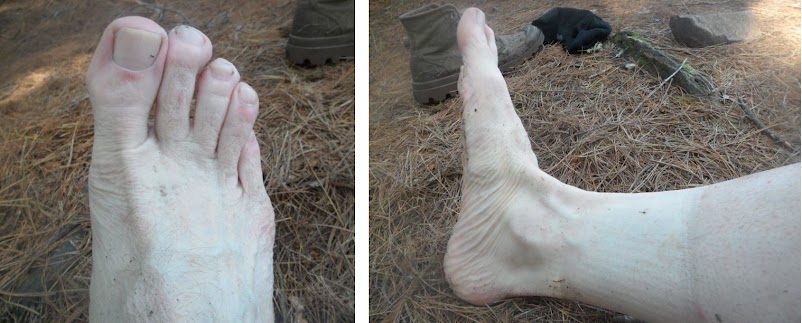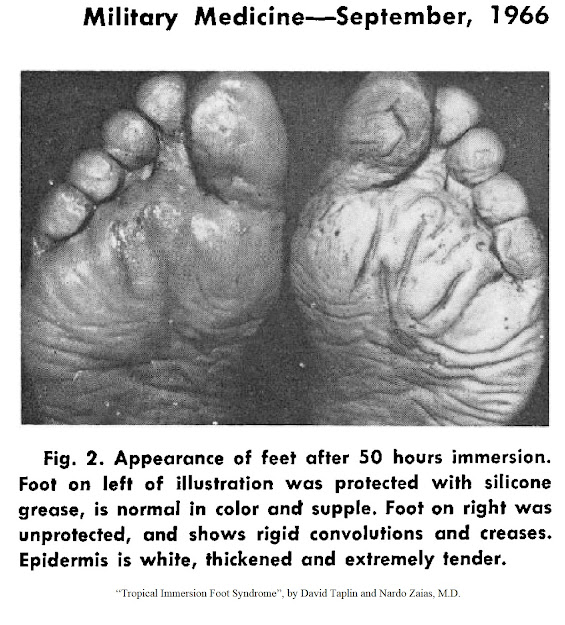This is part two of a two part series on immersion
foot, which can develop, depending on the temperature, into either trench foot
(NFCI), warm water immersion foot (WWIF) , or tropical immersion foot (TIF),
for more read “Wet Feet! ... Immersion Foot!? Part One©”, HERE
–Author’s Note
Okay,
your feet are wet and have been wet all day. It’s cold, or maybe it’s warm, it doesn’t really
matter, if you don’t do something soon, you’ll run the risk of immersion
foot.
Do
you know what to do? And how do you
prevent it anyways?
An ounce of
prevention, or a pound of cure!
So,
what can you do ahead of time, to prevent immersion foot?
First, always carry at least one extra pair of dry socks. Second, keep warm, because if your whole body becomes chilled or wet, you are more at risk for an immersion foot injury. It is important that your outer layer, when you are exposed to cold, wet weather, be as close to waterproof and windproof as possible, because like any cold injury, trench foot which is a non-freezing cold injury (NFCI), is aggravated by wind and windchill, and wet boots or gloves and evaporation, combine to cool the surface of your hands, feet, and ankles.
your hands or feet. All clothing should be loose because, if the cold induced lowered blood supply is compounded with a decreased circulation, due to constriction from tight fitting clothing or boots, it will drastically increase your chances of injury .
While
most people realize that tight boots or shoes are a problem, they seem to
forget that tight socks are also a problem.
And while it is often a good idea to wear two pairs of socks, it only works
if your boots are large enough to accommodate both comfortably. Also, if you are wearing two pairs of socks,
the outside pair should be a size larger than the inner pair.
By
the way, this holds true for gloves as well, cramming a pair of wool gloves into
a tight pair of leather gloves will only compress your fingers, reducing your
circulation and leading to cold fingers, which if they get wet, will lead to
trench hand. Ideally a pair of wool
gloves should be worn inside a pair loose, waterproof, cloth or leather mittens.
below the level of your heart. So, move around, exercise, wiggle your toes and fingers and lift your feet up above your heart level for short periods.
During
World War One, British soldiers were instructed to take off their boots,
whenever circumstances allowed, and dry their feet, before rubbing them with tallow,
lard, or whale oil1 and putting dry socks back on. At the time it was unclear to the researchers
whether it was the oil, or the foot rubbing that was the most beneficial in
preventing immersion foot.
During the American
War in Vietnam, it was found that
applying a thick coating of a hydrophobic balm, such as Vaseline® or a silicone
grease2, daily to the soles of the feet prevented warm water
immersion foot, by preventing the hyperhydration and pruning of the soles of
the feet. Silicone grease is a chemically
inert, non-volatile, non-biodegradable polymer, which is difficult to wash off
and maintains its viscosity, or stickiness, at human body temperatures, it is
composed of silicone, carbon, hydrogen, and oxygen, and it is adhesive, water
repellent and easy to apply. Silicone
grease is a better choice for this purpose than petroleum greases like Vaseline®,
which can be used as a food source by Pseudomonas aeruginosa, a
gram-negative, bacterium found commonly in soil and water, and which can cause
a variety of infections in humans.
Additionally, Vaseline® very easily, loses nearly all its viscosity.
In
a study done in the early 1960s3, in a remote area of the
Everglades, six volunteers put a liberal coating of Dow Corning High Vacuum
Grease to their left foot only. It was
reapplied every 12 hours, throughout the 72 hours of the experiment, and other
than those times, the volunteers were not allowed to remove their socks and
boots. During the experiment, 80% of the
participants suffered extreme tenderness, sensitivity to pressure and gross
swelling of the epidermis of their unprotected right foot after 36 hours, and
after 72 hours 50% of the volunteers could only walk with considerable
pain. The natural creases of their right
feet were greatly exaggerated, and additional folds formed, and the normally
supple sole of their right foot was transformed into a rigid, pale, creased
surface.
However,
the left foot, which was protected by silicone grease, remained comfortable
throughout the entire experiment in all cases, and the tenderness of the sole
of the foot, which 80% of the participants suffered in their right feet, was
notably absent. The silicone grease
protected the volunteers’ left feet, which only showed some exaggeration of the
creases and thickening of the soles, but to a lesser degree than in the right
feet. All the volunteers noted that they
had no pain in their left foot, and that the left foot felt warmer than the
other foot when immersed in water.
Maceration,
the only warning sign you’ll get...
 |
Early stages of immersion-foot. Note, the blanched and macerated appearance of my foot and how the area below the sock line is paler than the area above it. Notice also, how my toenails are pale and not a healthy pink. My foot had been wet for about 8 hours, while canoeing on a windy, 70oF (21oC) day. Photographs by the Author.
Maceration,
or pruning, is the only warning sign you are going to get, so inspect your
feet! In the early stage of maceration,
there won’t be any pain, swelling or redness, just skin that has become pale,
wrinkly, and soft. At this point, you
don’t have immersion foot, the skin pruning is simply a warning. However, if you don’t take care of your feet soon,
this condition will lead to a full blown immersion foot injury, either trench foot (NFCI), warm water immersion foot (WWIF) , or
tropical immersion foot (TIF)!
Controlling
maceration...
During WWII, in the European theater, trench foot was a problem, and the US Army recommended a daily foot inspection, looking for
swelling and discoloration. The men were ordered to be aware of any sensations of tingling or numbness and were ordered to change their socks daily. Today, it is recommended that you look for pale, macerated, or wrinkled skin and take corrective steps immediately.
Captain George Wilson, in his auto biography, If You Survive, rinsed his feet daily with cold water, since he didn’t have any warm water
or soap, drying them with his old socks and putting on his dry, clean socks. He then washed his old socks, wringing them out as dry as he could, before putting them inside his shirt, on a string, against his body to dry.
Additionally, during the American
War in Vietnam, it was found that warm water immersion foot could be prevented
by a daylong period of drying out, following every two to three days of
exposure to wet conditions. It was also
found that to prevent warm water immersion foot, the feet should be allowed to
dry overnight for eight of each twenty-four hours4.
So,
if your feet or hands are wet, pale, and shriveled, dry them! At least once a day stop and wash your hands
and feet with soap and water and then dry, rub, and massage them to stimulate
the circulation, before putting on a dry pair of socks or gloves. If your socks or gloves are wet, change to a
dry pair. At night take off your boots,
if possible, and dry both them and their insoles.
By
keeping your feet and hands, dry and clean, and by coating them with a
hydrophobic balm, you can prevent the onset of trench foot (NFCI), warm water
immersion foot (WWIF) , or tropical immersion foot (TIF).
Don’t forget to come back next week and read “Sherlock Holmes and The
Curious Case of The Scalded Feet©”, where we will talk about the curious case of
George Roger Clark and his scalded feet, which occurred in 1776, during a
journey through the wilderness of Kentucky and Virginia.
I
hope that you continue to enjoy The Woodsman’s Journal Online and look for me
on YouTube at BandanaMan Productions for other related videos, HERE. Don’t forget to follow me on both The
Woodsman’s Journal Online, HERE,
and subscribe to BandanaMan Productions on YouTube. If you have questions, as always, feel free
to leave a comment on either site. I
announce new articles on Facebook at Eric Reynolds, on Instagram at
bandanamanaproductions, and on VK at Eric Reynolds, so watch for me.
That
is all for now, and as always, until next time, Happy Trails!
Notes
1
From “Prophylaxis of Trench Foot” by Raymond Greene, D.M., M.R.C.P. and “Prophylaxis of Warm-Water-Immersion Foot”, by Larry J.
Buckels M.D., et al.
2 From
Internal Medicine in Vietnam: Skin Diseases in Vietnam,
1965-72, Lt Col. Alfred M. Allen, page
115-117
3 From
“Prophylaxis of Trench Foot” by Raymond Greene, D.M.,
M.R.C.P. and “Prophylaxis of Warm-Water-Immersion Foot”, by Larry J.
Buckels M.D., et al.
4 From
Internal Medicine in Vietnam: Skin
Diseases in Vietnam, 1965-72, Lt Col. Alfred M. Allen, page 113 and “Tropical Immersion
Foot Syndrome”, by David Taplin and Nardo Zaias, M.D.
Sources
Allen, Alfred M., Lt Col.; Internal Medicine in Vietnam:
Skin Diseases in Vietnam, 1965-72, Vol. I, [Office of the Surgeon General
and Center of Military History, Washington, D.C., 1977], p 102-117, https://books.google.com/books?id=Quw5DlbHKt0C&pg=PR17&dq=Internal+Medicine+in+Vietnam:+Skin+Diseases+in+Vietnam,+1965-72&hl=en&newbks=1&newbks_redir=0&sa=X&ved=2ahUKEwiw1cjXjqP9AhWID1kFHf7qBEoQ6AF6BAgEEAI#v=onepage&q=Internal%20Medicine%20in%20Vietnam%3A%20Skin%20Diseases%20in%20Vietnam%2C%201965-72&f=false, accessed 2/19/2023
Buckels, Larry J., M.D., et al. “Prophylaxis of
Warm-Water-Immersion Foot”, Journal of the American Medical Association, May
22, 1967, Volume 200, Issue 8, pages 681-683, reprinted in United States Navy
Medical Newsletter, Volume 50, No. 3, May 4, 1964, page 3 to 4, https://books.google.com/books?id=v7HE5_1Z5XQC&pg=RA2-PA1&lpg=RA2-PA1&dq=silicone+grease+use+of+your+feet+tropical+immersion+foot&source=bl&ots=dnv_M23aRn&sig=ACfU3U2Gy4xrnRhZfG1KWPjRs7hR1QcajA&hl=en&sa=X&ved=2ahUKEwi99czrn7z9AhWIGlkFHVv6Aww4ChDoAXoECAIQAw#v=onepage&q=silicone%20grease%20use%20of%20your%20feet%20tropical%20immersion%20foot&f=false, accessed March 1, 2023
Department
of the Army; Foot Marches, FM 21-18, June 1990,
[Washington D.C.], https://www.elon.edu/assets/docs/rotc/FM%2021-18%20Foot%20Marches.pdf,
accessed March 1, 2023
“Prophylaxis
of Trench Foot” by Raymond Greene, D.M., M.R.C.P.
Jordan,
Ryan; “Maceration, Immersion Foot and Backpacking”, September 15, 2019, [©
Beartooth Media Group Inc.], https://backpackinglight.com/maceration-immersion-foot-and-backpacking/,
accessed February 21, 2023
McCormack, Neil MD., and
Bitter, Cindy Carol MD., MPH., “My Feet Are Killing Me: A Hiker’s Journey”, Wilderness
& Environmental Medicine 2020; June 2020, Volume 31, Issue 2, pages 245 –
246, https://www.wemjournal.org/article/S1080-6032(20)30009-0/fulltext#articleInformation,
accessed February 17, 2022
Taplin, David, and Zaias,
Nardo, M.D.; “Tropical Immersion Foot Syndrome”, page 814 to 818, http://academic.oup.com/milmed/article-pdf/131/9/814/24623551/milmed-131-9-814.pdf,
accessed March 1, 2023
United
States Army, “Baby Your Feet”, Army Talks,
Vol. III, No. 5, February 10, 1945, page 7-9, 18, http://www.90thidpg.us/Reference/Army%20Talks/foxhole.pdf,
accessed January 18, 2023
United
States Army Medical Service; Cold Injury, Ground Type, in World War II,
Medical Department of the United States Army in World War II, [The Office of
the Surgeon General, Washington, D.C., 1958], https://books.google.com/books?id=FGcwAAAAIAAJ&pg=PA122&lpg=PA122&dq=%22War+Department+Circular+No.+312.+section+IV,+dated+22+July+1944%22&source=bl&ots=BA1svMxtQ9&sig=ACfU3U1mOBWMsSPXvQ1GCQ2N3WQGQb4yYQ&hl=en&sa=X&ved=2ahUKEwi0sOnI7vr8AhV4QjABHdSEBrwQ6AF6BAgIEAM#v=onepage&q=%22War%20Department%20Circular%20No.%20312.%20section%20IV%2C%20dated%2022%20July%201944%22&f=false, accessed February 3, 2023
Wilson,
George; If You Survive, [Ivy Books, New York, 1987] page 206-207















No comments:
Post a Comment